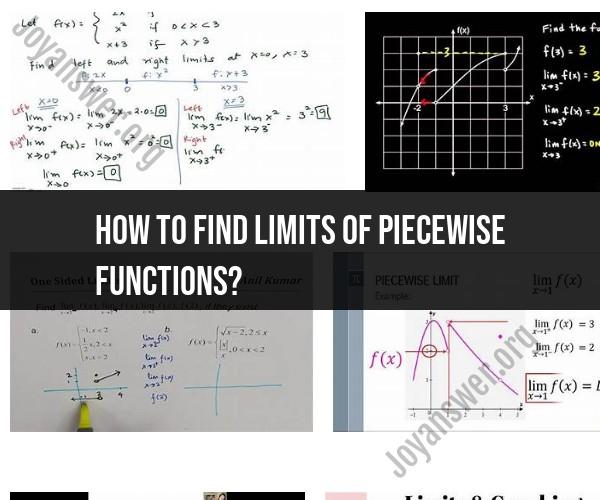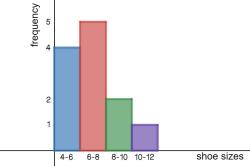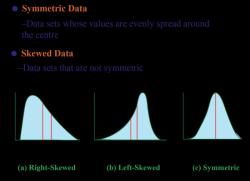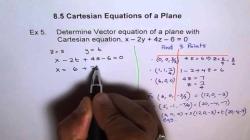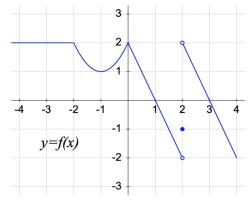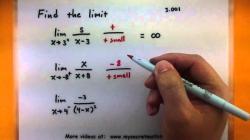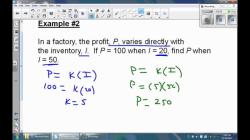How to find limits of piecewise functions?
Finding limits of piecewise functions involves evaluating the limit as the independent variable approaches a specific value from both the left and right sides of that value, taking into account the different expressions defined within the piecewise function's intervals. Here are step-by-step tips on how to find limits of piecewise functions:
Identify the Interval: Determine which interval of the piecewise function the limit is associated with. You'll need to focus on the expression and conditions that apply in that particular interval.
Evaluate the Left-Side Limit: Calculate the limit as the independent variable () approaches the target value from the left side of the interval. To do this, substitute a value of that is slightly less than the target value into the expression for that interval.
Evaluate the Right-Side Limit: Calculate the limit as approaches the target value from the right side of the interval. Substitute a value of that is slightly greater than the target value into the expression for that interval.
Compare the Two Limits: Compare the left-side limit and the right-side limit. If they are equal, and if the function is continuous at that point (i.e., there are no "jumps" or "holes" in the graph), then the overall limit exists, and its value is equal to the left-side and right-side limits.
Consider the Endpoints: Pay attention to the endpoints of the interval. If the target value is an endpoint of the interval and the expression for that interval is defined at the endpoint, use that expression. If not, you may need to consider whether the limit approaches a finite value or approaches infinity or negative infinity at that endpoint.
Repeat for Other Intervals: If your piecewise function has multiple intervals, repeat the process for each interval where you need to find a limit.
Example: Let's find the limit of the piecewise function at using the following piecewise rules:
- for
- for
- for
To find the limit at , calculate the left-side limit:
And calculate the right-side limit:
Since the left-side limit and right-side limit are not equal, the overall limit at does not exist for this piecewise function.
Finding limits of piecewise functions can involve considering different expressions and conditions for different intervals, so it's important to carefully analyze each interval and its behavior as approaches the target value.
To calculate the limit of a piecewise function, you need to consider the following:
- The limit of a function as x approaches a value a is the value that the function approaches as x gets closer and closer to a from either the left or the right.
- The limit of a piecewise function is the limit of the function over the interval to which x approaches.
To find the limit of a piecewise function at a point, you need to find the limit of the function for each interval that x approaches, and then compare the two limits. If the two limits are equal, then the limit of the function at that point exists and is equal to that value. If the two limits are not equal, then the limit of the function at that point does not exist.
Here is an example of how to find the limit of a piecewise function:
f(x) =
{
x + 1, if x < 0
x^2, if x >= 0
}
What is the limit of f(x) as x approaches 0?
To find the limit, we need to find the limit of the function for each interval that x approaches.
The limit of the function as x approaches 0 from the left is equal to 0 + 1 = 1.
The limit of the function as x approaches 0 from the right is equal to 0^2 = 0.
Since the two limits are not equal, the limit of the function at x = 0 does not exist.
Here is another example:
f(x) =
{
10, if x <= 10
10 + 2(x - 10), if x > 10
}
What is the limit of f(x) as x approaches 10?
To find the limit, we need to find the limit of the function for each interval that x approaches.
The limit of the function as x approaches 10 from the left is equal to 10.
The limit of the function as x approaches 10 from the right is also equal to 10.
Since the two limits are equal, the limit of the function at x = 10 exists and is equal to 10.
Strategies for Evaluating and Analyzing Limits of Piecewise Functions
Here are some strategies for evaluating and analyzing limits of piecewise functions:
- Identify the different intervals over which the function is defined. This can be done by considering the problem or situation that you are trying to model.
- Write a separate equation for each interval. Each equation should describe how the output value of the function changes as the input value changes within the interval.
- Find the limit of the function for each interval that x approaches. This can be done using direct substitution, factorization, or other algebraic methods.
- Compare the limits of the function for each interval. If the two limits are equal, then the limit of the function at that point exists and is equal to that value. If the two limits are not equal, then the limit of the function at that point does not exist.
Conclusion
Limits of piecewise functions can be tricky to evaluate, but by following the strategies above, you can improve your ability to solve these problems.
